|
|
|
Sort Order |
|
|
|
Items / Page
|
|
|
|
|
|
|
| Srl | Item |
| 1 |
ID:
089386


|
|
|
|
|
| Publication |
2009.
|
| Summary/Abstract |
Despite the contemporary importance of the Ridge forest to the city of Delhi as its most important 'green lung', the concept of urban forestry has been explored neither by urban historians studying Delhi nor by environmental historians. This article places the colonial efforts to plant a forest on the Delhi Ridge from 1883 to 1913 within the context of the gradual deforestation of the countryside around Delhi and the local colonial administration's preoccupation with encouraging arboriculture. This project of colonial forestry prioritized the needs of the white colonizers living in Delhi, while coming into conflict repeatedly with indigenous peasants. With the decision to transfer the capital to Delhi in 1911, the afforestation of the Delhi Ridge received a further stimulus. Town planners' visions of a building the capital city of New Delhi were meant to assert the grandeur of British rule through imposing buildings, with the permanence of the British in India being emphasised by the strategic location of the ruins of earlier empires within the city. The principles of English landscape gardening inspired the planning of New Delhi, with the afforestation of the Delhi Ridge being undertaken to provide a verdant backdrop for-the Government House and the Secretariat-the administrative centre of British government in India. Imperial notions of landscaping, which were central to the afforestation of the Delhi Ridge epitomised colonial rule and marginalized Indians.
|
|
|
|
|
|
|
|
|
|
|
|
|
|
|
|
| 2 |
ID:
188164
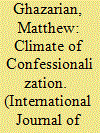

|
|
|
|
|
| Summary/Abstract |
After the 1877–78 Russo-Ottoman War, the Ottoman Empire saw the rise of ethnic and sectarian clashes in Anatolia, the Balkans, and elsewhere, and the task of explaining that rise remains unfinished. Many have examined the intellectual formations of ethnic and sectarian solidarities after 1878, but the availability of new ideas cannot alone account for their widespread uptake. Why after 1878 did ordinary people respond more to calls upon ethnic and sectarian solidarity? Drawing on sources surrounding the 1879 famine in the Ottoman East, this article steps away from imperial metropoles to examine overlapping environmental, financial, and technological disjunctures. Adopting the methods of political ecology, the article underscores the simultaneous effects of drought, sovereign default, and an influx of modern weapons, each of which imposed uneven hardships along ethno-religious lines. Together, they created a climate of lived confessionalization that highlighted the communal categories upon which emergent movements called.
|
|
|
|
|
|
|
|
|
|
|
|
|
|
|
|
| 3 |
ID:
184210


|
|
|
|
|
| Summary/Abstract |
The 17th century was a period of transition in world history. It was marked globally by social movements emerging in response to widespread drought, famine, disease, warfare, and dislocation linked to climate change. Historians have yet to situate Safavid Iran (1501–1722) within the “General Crisis.” This article, coauthored by an environmental historian and a climate scientist, revisits primary sources and incorporates tree-ring evidence to argue that an ecological crisis beginning in the late 17th century contributed to the collapse of the imperial ecology of the Safavid Empire. A declining resource base and demographic decline conditioned the unraveling of imperial networks and the empire's eventual fall to a small band of Afghan raiders in 1722. Ultimately, this article makes a case for the connectedness of Iran to broader global environmental trends in this period, with local circumstances and human agency shaping a period of acute environmental crisis in Iran.
|
|
|
|
|
|
|
|
|
|
|
|
|
|
|
|
| 4 |
ID:
163846
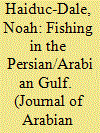

|
|
|
|
|
| Summary/Abstract |
The last two centuries have brought dramatic changes to the Persian/Arabian Gulf. Yet while imperial politics and newfound wealth altered much about coastal Gulf societies, fishing remained a remarkably steady enterprise. Rather than immediately changing alongside regionally altering events, fishing provided a stable livelihood for many Gulf coast residents throughout the eighteenth and nineteenth centuries, and even beyond the first half of the twentieth century. The main contention of this paper is that due to environmental limitations, the Gulf provided enough resources for local consumption, but not enough to justify large investment by foreign powers, such as the British Empire. This fact left local fishermen and political leaders in control of fishing. It also enabled fishermen to adapt to new technologies and markets at their own pace, rather than being compelled to do so by imperial powers. Even the twentieth century oil economy initially provided new markets for traditional fisheries rather than replacing them with industrial fishing fleets.
|
|
|
|
|
|
|
|
|
|
|
|
|
|
|
|
| 5 |
ID:
103623
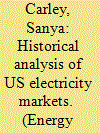

|
|
|
|
|
| Publication |
2011.
|
| Summary/Abstract |
This paper evaluates whether the U.S. electricity sector is directed away from carbon-intensive technological lock-in, and which factors are contributing, or have potential to contribute, to a possible reorientation of the industry. With the application of a historical analysis of the electricity sector from the late nineteenth century through current day, this analysis finds that, although the industry still relies primarily on carbon-intensive fossil fuel operations, several recent trends indicate that the industry is becoming less carbon intensive, smaller in generation system scale, and more sustainable in operations. Crucial drivers-firm level interactions with technological change, industry leadership and market structure, government intervention and policy momentum, and citizen involvement and behavior patterns-that have traditionally shaped the structure, scale, and environmental footprint of the industry, have also played a prominent role in recent transformations. These results indicate that triggering or extraordinary events may not be necessary to initiate an escape from carbon lock-in in the electricity sector. Complete escape is not yet definitive, however, and it remains to be seen whether the industry is able to transform entirely before any significant climate change disturbances occur.
|
|
|
|
|
|
|
|
|
|
|
|
|
|
|
|
| 6 |
ID:
177796
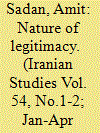

|
|
|
|
|
| Summary/Abstract |
This article examines history-writing in Safavid Iran and, in particular, the notable chronicle from the time of Shah ʿAbbas I, the Tārīkh-e ʿĀlam-ārā-ye ʿAbbāsī (TAAA). It rethinks Safavid history-writing via the perspective of environmental history. This article asks, “How was the natural world represented in the chronicle, and in what way did this representation shape the Safavid historical narrative?” It argues that the ways in which the TAAA portrays human encounters with nature suggest ʿAbbas’ unique sovereignty over it. Because of his piety and devotion, he was considered blessed with divine grace, making him the only human being with the ability to regulate natural manifestations—that is, to dominate, to manipulate, to survive, and to contain nature. Against a backdrop of an absence of environmental readings of Safavid history, the article suggests looking at the TAAA’s representation of this natural world as a powerful legitimizing force for ʿAbbas’ reign, as it is one that has not yet been foregrounded.
|
|
|
|
|
|
|
|
|
|
|
|
|
|
|
|
| 7 |
ID:
159008
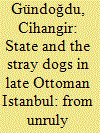

|
|
|
|
|
| Summary/Abstract |
The present article situates the systemic efforts to annihilate stray dogs within the wider picture of Ottoman modernizing reforms in the nineteenth century. The period under investigation witnessed an increasing desire on the part of the modern Ottoman state to control and reform disenfranchised human and animal groups, which were believed to jeopardize public order, security and hygiene. These groups – beggars, orphans and the unemployed – were identified as actors irreconcilable with the modern image that the reforming bureaucracy and modernizing elites sought to project. In the face of increasing challenges from European powers, they were the epitome of underdevelopment and backwardness. Ottoman elites and official authorities therefore proposed and implemented institutional measures in the form of forced labor, reformatories or deportation to reform the conditions of these groups, segregate them from the greater public and discipline them. In the modern period, along with the proposals that called for the removal of dogs, modernizing intellectuals and professionals proposed alternative plans to render non-human animals beneficial to human needs and the modern state's expectations.
|
|
|
|
|
|
|
|
|
|
|
|
|
|
|
|
| 8 |
ID:
141047
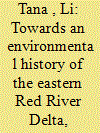

|
|
|
|
|
| Summary/Abstract |
This article focuses on the eastern region of the Red River Delta, Vietnam, between the tenth and sixteenth centuries. This area was an important centre of economic and population growth in Đại Việt in the thirteenth and fourteenth centuries, and nurtured Đại Việt's sophisticated and renowned ceramics industry, hosted leading schools of Vietnamese Buddhism and bred a rising class of scholars and bureaucrats. The region's rapid rise as an economic and political centre was, however, also the key to its undoing. The sudden spike in population density, and the intensive logging carried out for ceramic production, and temple and ship building, overtaxed the area's natural resources. The burden on the local ecology was exacerbated by the Trần dynasty's dyke building project, which shifted the river's course. The ensuing environmental deterioration might have been one major reason for the Vietnamese forsaking the large-scale ceramic production in Chu Đậu, deserting their main port, Vân Đồn, and for the Chinese abandoning a historical maritime invasion route.
|
|
|
|
|
|
|
|
|
|
|
|
|
|
|
|
|
|
|
|
|